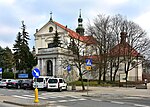Saxon Garden
1727 establishments in the Polish–Lithuanian CommonwealthGardens in PolandParks in PolandParks in WarsawUrban public parks ... and 1 more
Śródmieście, Warsaw

The Saxon Garden (Polish: Ogród Saski) is a 15.5–hectare public garden in central (Śródmieście) Warsaw, Poland, facing Piłsudski Square. It is the oldest public park in the city. Founded in the late 17th century, it was opened to the public in 1727 as one of the first publicly accessible parks in the world.
Excerpt from the Wikipedia article Saxon Garden (License: CC BY-SA 3.0, Authors, Images).Saxon Garden
Niecała, Warsaw Śródmieście (Warsaw)
Geographical coordinates (GPS) Address Nearby Places Show on map
Geographical coordinates (GPS)
| Latitude | Longitude |
|---|---|
| N 52.240555555556 ° | E 21.008611111111 ° |
Address
Pamięci o Marszałku Piłsudskim
Niecała
00-098 Warsaw, Śródmieście (Warsaw)
Masovian Voivodeship, Poland
Open on Google Maps











